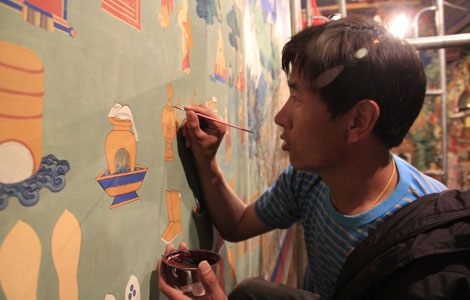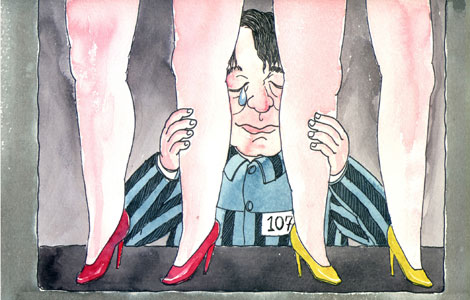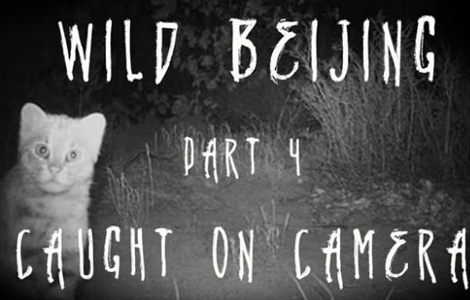10 royal baby traditions to know
Updated: 2013-07-22 16:40
(Agencies)
|
|||||||||||
LONDON - Prince William and Kate are seen as the new face of a centuries-old institution, keeping the best of traditions while moving forward with the times. Here are 10 things to know about the royal baby in relation to royal births of the past:
HOME BIRTHING
Most people take a hospital birth for granted these days, but just a few decades ago the custom among royals - as it was among commoners - was to give birth at home.
Queen Elizabeth II was born at 17 Bruton Street in London, a private family home, and she gave birth to her sons Charles, Andrew and Edward in Buckingham Palace. Her only daughter, Princess Anne, was born at Clarence House, also a royal property.
That changed by the 1980s, when Princes William and Harry were both born at the private Lindo Wing of St. Mary's hospital in central London.
HOME SCHOOLING
For a long time, royals were educated in private. The queen was taught at home by her father, tutors and governesses, and never mingled with commoners at a school, college or university.
Charles was the first royal heir to have gone to school, and William and Kate, who were both educated at independent schools, will doubtless have their child do the same.
DADS IN THE DELIVERY ROOM
William has said he "fully intends" to be there with Kate when she gives birth, in line with the expectations of many modern parents. He follows in the footsteps of his father, Charles, who declared how much he relished being in the delivery room in a letter to his godmother, Patricia Brabourne.
"I am so thankful I was beside Diana's bedside the whole time because by the end of the day I really felt as though I'd shared deeply in the process of birth," Charles wrote shortly after William's birth.
Things were quite different when Charles was born. When the queen (then Princess Elizabeth) went into labor, her husband, Prince Philip, was off playing squash in the palace - out of restlessness, not indifference, noted Charles' biographer Jonathan Dimbleby.
OFFICIAL INTRUDERS
In the early 1900s - and probably before - custom dictated that government officials should be present when a royal was born. When the queen was born in 1926, for example, the home secretary was present among the doctors.
The current home secretary, Theresa May, said the centuries-old tradition required the official to attend "as evidence that it was really a royal birth and the baby hadn't been smuggled in." Fortunately for Kate - the practice was abolished years ago by George VI.
The custom is thought to have been linked to the so-called "warming pan plot" of 1688, when rumors swirled that the supposed child of James II was sneaked into the delivery room in a long-handled bed-warming pan. Some 40 to 60 people were said to have dropped in to witness the birth.
HOW MANY NAMES?
Apart from the baby's gender, the biggest guessing game ahead of the royal birth has to be the name. Most royals have three to four first names, usually in a combination that honors previous monarchs or relatives. The queen's full name is Elizabeth Alexandra Mary, after her mother, great-grandmother and grandmother, and William's full name is William Arthur Philip Louis.
If you believe the bookmakers, the royal baby's first name is most likely to be Alexandra, Charlotte, Elizabeth, or George. In any case, it could take a while for the public to find out the future monarch's name. When William was born, it took a full week before his name was announced.
Related Stories
UK awaits news of royal baby 2013-07-21 09:50
Royals 'waiting by telephone' for Kate's baby 2013-07-17 15:18
UK waits for newest addition to royal family 2013-07-12 07:54
Royal baby-inspired afternoon tea in London 2013-07-11 15:59
Postal workers to get shares in private Royal Mail 2013-07-10 21:07
Luxury baby suite as UK awaits royal birth 2013-07-10 16:06
Today's Top News
Chinese police question employee of AstraZeneca
Quake in NW China kills 89, injures 700
Kate gives birth to a baby boy
New visas to boost family reunions
Huawei launches mobile app contest in EU
China to implement stricter air quality controls
China's FX purchases decline
Police get drug giant's help in bribery scandal
Hot Topics
Lunar probe , China growth forecasts, Emission rules get tougher, China seen through 'colored lens', International board,
Editor's Picks

|

|

|

|

|

|





